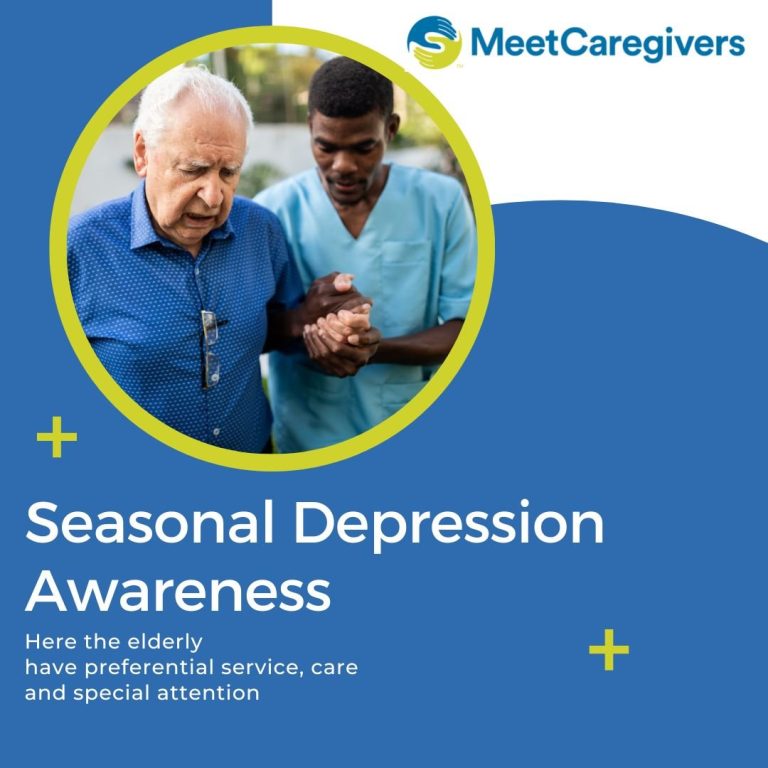
Seasonal Depression Awareness Month raises awareness about Seasonal Affective Disorder (SAD) and the various ways to relieve its symptoms. Keep reading to learn more.
Seasonal Depression Awareness Month Supports Year-Round Wellbeing
Despite the long, dark days, December can be the most wonderful time of the year for most people. But it’s also the time for the winter blues for many others. For this reason, December has been designated as Seasonal Depression Awareness Month.
Seasonal Depression Awareness Month is an obscure observance intended to educate the public about seasonal depression, also known as Seasonal Affective Disorder (SAD), and the various ways to alleviate its symptoms.
Seasonal Affective Disorder is more prevalent in regions with harsher winters. But, like other mental health conditions, this condition doesn’t discriminate. It affects individuals of all ages, though older adults may have a higher risk.
Depression in the elderly is often overlooked or mistaken for other symptoms. For example, depression can cause memory issues, which may be mistaken for cognitive decline or the typical effects of aging.
Consequently, older adults may not receive the necessary mental health treatment to enhance their wellbeing. For this reason, it’s essential to be aware of the symptoms of depression so you can help your loved ones when they need it.
What Is Seasonal Depression?
Seasonal Affective Disorder is a form of depression triggered by seasonal changes. It can cause bouts of fatigue, depression, and social withdrawal due to a biochemical imbalance in the brain.
Most people who experience this condition reside far from the equator, where there is less daylight during the winter. However, other causes of Seasonal Affective Disorder include:
- Oversleeping
- Limited mobility
- Lack of social support
- Withdrawal from friends or relatives
- Overeating, which frequently leads to weight gain.
Seasonal Affective Disorder is more than the “winter blues.” According to the non-profit organization Mental Health America, it affects approximately 5% of the population, or more than 16.4 million Americans.
Seasonal Affective Disorder is most commonly associated with fall and winter. However, it is more likely to affect adults with major depressive or bipolar disorder. Unfortunately, this condition can also be inherited.
What Are The Symptoms Of Seasonal Depression?
Mental health experts don’t classify Seasonal Affective Disorder as an express condition. Rather, it is a form of depression characterized by its seasonal recurrence, with symptoms lasting approximately four to five months per year.
The symptoms of Seasonal Affective Disorder include many of those associated with major depression, as well as more specific symptoms, such as:
- Change in appetite
- Change in sleeping patterns
- Thoughts of death or suicide
- Loss of energy or increased fatigue
- Loss of interest or pleasure in activities
- Feeling sad or having a depressed mood
- Difficulty thinking, concentrating, or making decisions.
Seasonal Depression Awareness Month Promotes Healthy Coping Strategies
Managing the symptoms of Seasonal Affective Disorder is one of the best things you can do for your health. You deserve to feel happy and well all year round. Help is available if you or an elderly loved one is experiencing symptoms of Seasonal Affective Disorder. Here are a few treatment ideas:
- Light therapy: A light box can promote light exposure throughout winter. This method is one of the most widely used therapies for seasonal affective disorder. These devices have a similar effect on the body as sunlight. Over time, light boxes help users to adjust their circadian rhythm and the levels of various hormones and neurotransmitters that affect mood and energy.
- Engaging in routine, healthy social interactions: Meeting with friends or family, even for a short time, is also great for mental health. Spending time with loved ones can help lift your mood, even if it’s hard to be sociable when the weather outside is cold, dark, and dismal.
- Therapy: Counseling for the elderly is another beneficial treatment for Seasonal Affective Disorder. Therapy might help you figure out what’s triggering your seasonal depression and what’s making your symptoms worse.In addition, yourr counselor will work with you to develop strategies for dealing with negative thoughts so that they no longer dictate your outlook on life.
MeetCaregivers Supports Seasonal Depression Awareness Month
Seasonal Affective Disorder, or seasonal depression, affects 16.4 million Americans alone. Metabolic imbalances in the brain caused by seasonal changes trigger this type of depression. Most people who develop this condition live in Northern climates far from the equator. These regions have longer, darker, harsher winters.
If your loved one struggles with mental health due to loneliness or isolation, we can help. A qualified caregiver can ensure they attend counseling appointments, provide companionship, and more. Call 1 (888) 541-1136 or Find A Caregiver today.
For more resources about aging in place and caregiving, visit our Blog.
- Associates in Family Medicine. (2016, December 1). December is Seasonal Depression Awareness Month. December is Seasonal Depression Awareness month — Associates in Family Medicine. Retrieved December 19, 2022, from https://afmed.org/december-is-seasonal-depression-awareness-month/
- Donohue, M. (2022, December 3). How Seasonal Affective Disorder (SAD) Affects Seniors? Retrieved December 19, 2022, from https://bluemoonseniorcounseling.com/what-is-seasonal-affective-disorder-sad-and-how-does-it-affect-seniors/
- Valley Oaks Health. (2020, November 30). December is Seasonal Affective Disorder Awareness Month. December is Seasonal Affective Disorder Awareness Month – Valley Oaks Health. Retrieved December 19, 2022, from https://valleyoaks.org/health-hub/december-is-seasonal-affective-disorder-awareness-month/
